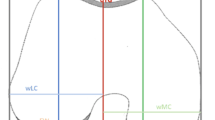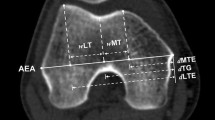Abstract
Different surgical techniques have been described to correct trochlear dysplasia, without clear descriptions of the various types of trochlear dysplasia. In describing trochlear dysplasia, there exist no clear criteria to distinguish between decreased trochlear depth (heightened trochlea floor) and flattened lateral and/or medial condylar height. The current study aims to build a database of axial MRI measurements of normal and abnormal trochlear shape to create a foundation for the selection of the necessary surgical correction to more normal trochlear anatomy. We prospectively examined 152 subjects: 30 patients with patellar instability due to trochlea dysplasia and 122 subjects without any symptoms or objective findings related to the patellofemoral joint. MRI was performed in both groups. The height of the medial and lateral condyle, and the center of the trochlea was measured on axial MR images. The height of these different locations was compared to the total width of the femoral condyle and expressed in percentages. The statistical analysis was conducted with the Student’s t test at SPSS software. For intraobserver reliability 20 randomly taken MRI were evaluated twice. The intraobserver reliability was determined by calculating the kappa values investigated parameter. In normal subjects, the height of the lateral condyle was 81% of the width of the femoral condyle (100 units),the trochlear central height was 73%, the medial condylar height was 76%. In patients with patellar instability, the lateral condylar height was 82% and showed no significant difference compared to the normal group (P = 0.082). The trochlear central (77%) and medial condylar height (79%) were significantly different (P < 0.001) compared to the normal subjects. The location of pathology in patients with patellar instability was decreased lateral condylar height in five cases (16.6%) and decreased central/medial height in 25 cases (83.4%). A height of the lateral condyle <77% was documented to be pathologic. There was also a significant difference (P < 0.001) between males and females comparing the different heights of the trochlea to the total width of the femoral condyle. The resultant percentages of all three height measurements, the lateral, central, and medial heights, were greater in males than in females. The intraobserver reliability was perfect for all investigated parameters. In conclusion, (1) the presented measurement scheme on axial MRI is a reliable method to calculate the height of the trochlea in different locations, (2) a more objective assessment of the trochlear pathology is possible, (3) in five of six cases the pathology is located in the center and/or medial trochlea, and (4) in our series of patellofemoral instability patients, most would benefit from a deepening trochleaplasty as the surgical procedure of choice to correct dysplasia.








Similar content being viewed by others
References
Albee FH (1915) The bone graft wedge in the treatment of habitual dislocation of the patella. Med Rec 88:257–259
Arendt E (2005) Anatomy and malalignment of the patellofemoral joint: its relation to patellofemoral arthrosis. Clin Orthop Relat Res 436:71–75. doi:10.1097/01.blo.0000171543.60966.a6
Bereiter H, Gautier E (1994) Die Trochleaplastik als chirurgische Therapie der rezidivierenden Patellaluxation bei Trochleadysplasie des Femurs. Arthroskopie 7:281–286
Biedert RM (2004) Patellofemoral disorders: diagnosis and treatment. Wiley, New York
Biedert RM, Bachmann M (2008) Trochlea dysplasia: too much or not enough? In: Proceedings of the International Patellofemoral Study Group meeting, Stellenbosch, South Africa
Biedert RM (2008) Osteotomien. Orthopade 37:872–883. doi:10.1007/s00132-008-1294-5
Carrillon Y, Abidi H, Dejour D, Fantino O, Moyen B, Tran-Minh VA (2000) Patellar instability: assessment on MR images by measuring the lateral trochlear inclination—initial experience. Radiology 216:582–585
Dejour H, Walch G, Neyret P, Adeleine P (1990) Dysplasia of the femoral trochlea. Rev Chir Orthop Repar Appar Mot 76:45–54
Dejour H, Walch G, Nove-Josserand L, Guier C (1994) Factors of patellar instability: an anatomic radiographic study. Knee Surg Sports Traumatol Arthrosc 2:19–26. doi:10.1007/BF01552649
Dejour H, Walch G, Nove-Josserand L, Guier C (1994) Factors of patellar instability: an anatomoradiographic analysis. In: Feagin JA Jr (ed) The crucial ligaments. Diagnosis and treatment of ligament injuries about the knee. Churchill Livingstone, New York, pp 361–367
Dejour D, Le Coultre B (2007) Osteotomies in patellofemoral instabilities. Sports Med Arthrosc Rev 15:39–46. doi:10.1097/JSA.0b013e31803035ae
Donell ST, Joseph G, Hing CB, Marshall TJ (2006) Modified Dejour trochleoplasty for severe dysplasia: operative technique and early clinical results. Knee 13:266–273. doi:10.1016/j.knee.2006.01.004
Feinstein WK, Noble PC, Kamaric E, Tullos HS (1996) Anatomic alignment of the patellar groove. Clin Orthop Relat Res 331:64–73. doi:10.1097/00003086-199610000-00009
Keser S, Savranlar A, Bayar A, Ege A, Tuhan E (2008) Is there a relationship between anterior knee pain and femoral trochlear dysplasia? Assessment of lateral trochlear inclination by magnetic resonance imaging. Knee Surg Sports Traumatol Arthrosc 16:911–915. doi:10.1007/s00167-008-0571-5
Landis JR, Koch GG (1977) The measurement of observer agreement for categorical data. Biometrics 33:159–174. doi:10.2307/2529310
Malaghem J, Maldague B (1989) Depth insufficiency of the proximal trochlear groove on lateral radiographs of the knee: relation to patellar dislocation. Radiology 170:507–510
Masse Y (1978) Trochleoplasty: restoration of the intercondylar groove in subluxations and dislocations of the patella. Rev Chir Orthop Repar Appar Mot 64:3–17
Servien E, Neyret P, Si Selmi TA, Biedert RM (2004) Radiographs. In: Biedert RM (ed) Patellofemoral disorders: diagnosis and treatment. Wiley, New York, pp 87–100
Siegel S, Castellan NJ Jr (1988) Nonparametric statistics for the behavioral sciences, 2nd edn. McGraw-Hill, New York
Tavernier T, Dejour D (2001) Knee imaging: what is the best modality. J Radiol 82(387–405):407–408
Verdonk R, Jansegers E, Stuyts B (2005) Trochleoplasty in dysplastic knee trochlea. Knee Surg Sports Traumatol Arthrosc 13:529–533. doi:10.1007/s00167-004-0570-0
Von Knoch E, Böhm T, Bürgi ML, Von Knoch M, Bereiter H (2006) Trochleaplasty for recurrent patellar dislocation in association with trochlear dysplasia. J Bone Joint Surg 88B:1331–1335
Acknowledgments
Authors gratefully thank Eilzabeth A. Arendt, MD, Professor, University of Minnesota, Minneapolis for her help in manuscript preparation.
Author information
Authors and Affiliations
Corresponding author
Rights and permissions
About this article
Cite this article
Biedert, R.M., Bachmann, M. Anterior–posterior trochlear measurements of normal and dysplastic trochlea by axial magnetic resonance imaging. Knee Surg Sports Traumatol Arthrosc 17, 1225–1230 (2009). https://doi.org/10.1007/s00167-009-0824-y
Received:
Accepted:
Published:
Issue Date:
DOI: https://doi.org/10.1007/s00167-009-0824-y




